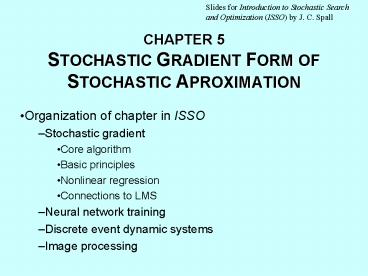CHAPTER 5 STOCHASTIC GRADIENT FORM OF STOCHASTIC APROXIMATION - PowerPoint PPT Presentation
Title:
CHAPTER 5 STOCHASTIC GRADIENT FORM OF STOCHASTIC APROXIMATION
Description:
Q( , V) represents 'observed' cost (noisy measurement of L ... Unbiased measurement satisfies key convergence conditions of SA (Section 4.3 in ISSO) ... – PowerPoint PPT presentation
Number of Views:38
Avg rating:3.0/5.0
Title: CHAPTER 5 STOCHASTIC GRADIENT FORM OF STOCHASTIC APROXIMATION
1
CHAPTER 5STOCHASTIC GRADIENT FORM OF STOCHASTIC
APROXIMATION
Slides for Introduction to Stochastic Search and
Optimization (ISSO) by J. C. Spall
- Organization of chapter in ISSO
- Stochastic gradient
- Core algorithm
- Basic principles
- Nonlinear regression
- Connections to LMS
- Neural network training
- Discrete event dynamic systems
- Image processing
2
Stochastic Gradient Formulation
- For differentiable L(?), recall familiar set of p
equations and p unknowns for use in finding a
minimum ?? - Above is special case of root-finding problem
- Suppose cannot observe L(?) and g(?) except in
presence of noise - Adaptive control (target tracking)
- Simulation-based optimization
- Etc.
- Seek unbiased measurement of ?L/?? for
optimization
3
Stochastic Gradient Formulation (Contd)
- Suppose L(?) EQ(?,?V?)
- V represents all random effects
- Q(?,?V) represents observed cost (noisy
measurement of L(?)) - Seek a representation where ?Q/?? is an unbiased
measurement of ?L/?? - Not true when distribution function for V depends
on ? - Above implies that desired representation is
- not
- where pV(?) is density function for V
4
Stochastic Gradient Measurement and Algorithm
- When density pV(?) is independent of ?,
- is unbiased measurement of ?L/??
- Above requires derivativeintegral interchange in
?L/?? ?EQ(?,?V)/?? E?Q(?,?V)/?? to be
valid - Can use root-finding (Robbins-Monro) SA algorithm
to attempt to find ?? - Unbiased measurement satisfies key convergence
conditions of SA (Section 4.3 in ISSO)
5
Stochastic Gradient Tendency to Move Iterate in
Correct Direction
6
Stochastic Gradient and LMS Connections
- Recall basic linear model from Chapter 3
- Consider standard MSE loss L(?)
- Implies Q
- Recall basic LMS algorithm from Chapter 3
- Hence LMS is direct application of stochastic
gradient SA - Proposition 5.1 in ISSO shows how SA convergence
theory applies to LMS - Implies convergence of LMS to ??
7
Neural Networks
- Neural networks (NNs) are general function
approximators - Actual output zk represented by a NN according to
standard model zk h(?,?xk) vk - h(?,?xk) represents NN output for input xk and
weight values ? - vk represents noise
- Diagram of simple feedforward NN on next slide
- Most popular training method is backpropagation
(mean-squared-type loss function) - Backpropagation is following stochastic gradient
recursion
8
Simple Feedforward Neural Network with p 25
Weight Parameters
9
Discrete-Event Dynamic Systems
- Many applications of stochastic gradient methods
in simulation-based optimization - Discrete-event dynamic systems frequently modeled
by simulation - Trajectories of process are piecewise constant
- Derivativeintegral interchange critical
- Interchange not valid in many realistic systems
- Interchange condition checked on case-by-case
basis - Overall approach requires knowledge of inner
workings of simulation - Needed to obtain ?Q(?,?V)/??
- Chapters 14 and 15 of ISSO have extensive
discussion of simulation-based optimization
10
Image Restoration
- Aim is to recover true image subject to having
recorded image corrupted by noise - Common to construct least-squares type problem
- where H ? s represents a convolution of the
measurement process (H) and the true
pixel-by-pixel image (s) - Can be solved by either batch linear regression
methods or the LMS/RLS methods - Nonlinear measurements need full power of
stochastic gradient method - Measurements modeled as Z F(s, x, V)































